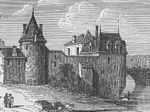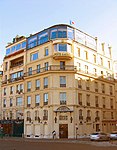Institut de Physique du Globe de Paris
The Institut de Physique du Globe de Paris - Université de Paris (IPGP, University of Paris; French for "Paris Institute of Earth Physics") is a French governmental, non-profit research and higher education establishment located in Paris, dedicated to the study of earth and planetary sciences by combining observations, laboratory analysis and construction of conceptual analogical and numerical models. IPGP is part of CNRS (UMR 7154) and University Paris-Diderot. It is the second largest CNRS research unit in France. The institute has 14 research divisions and 6 observatories. IPGP is also in charge by the French government of monitoring the active volcanoes on French territories in addition to the management of the worldwide network of seismological stations GEOSCOPE, and a major contribution to the worldwide network of magnetic observatories Intermagnet. IPGP maintains permanent volcanologic observatories on the islands of Réunion (Piton de la Fournaise), Guadeloupe (La Soufrière), and Martinique (Mount Pelée). The institute also maintains several analytical facilities in applied geophysics as well as a park of a variety of geophysical instruments. IPGP maintains three campuses in the Paris area. Until 2010, its main headquarters location is inside the Jussieu Campus in the 5th arrondissement of Paris. After 2010, it moved into a state of the art dedicated facility adjacent to the Jussieu Campus, in front of the Jardin des Plantes. IPGP has a second campus located in Paris-Diderot University in the 13th arrondissement of Paris where the geodesy and space sciences research, and undergrad teaching are done. The third campus is located 6 km to the east of Paris where it conducts space and planetary science activities ranging from building geophysical space instruments and sensors to planetary data analysis. IPGP maintain a staff of nearly 500 persons. The lead investigator (P.I.) for the seismometer instrument on the international space mission to Mars, InSight (launched 2018) is from this institute. Seismic Experiment for Interior Structure (SEIS) is a seismometer intended to operate on the surface of the planet Mars, hopefully increasing understanding of that planet and in turn the solar system and Earth interiors.
Excerpt from the Wikipedia article Institut de Physique du Globe de Paris (License: CC BY-SA 3.0, Authors).Institut de Physique du Globe de Paris
Rue Jussieu, Paris 5th Arrondissement (Paris)
Geographical coordinates (GPS) Address Website Nearby Places Show on map
Geographical coordinates (GPS)
| Latitude | Longitude |
|---|---|
| N 48.8473 ° | E 2.3568 ° |
Address
Sorbonne Université - Faculté des Sciences et Ingénierie
Rue Jussieu
75005 Paris, 5th Arrondissement (Paris)
Ile-de-France, France
Open on Google Maps










